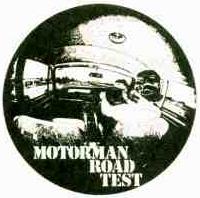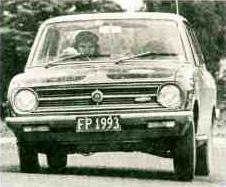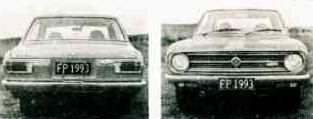|
|
MOTORMAN ROAD TEST - DATSUN 1200SSS
From MOTORMAN magazine, November, 1972 pages 15-16
 Album click to view Album click to view  Album click to view Album click to view
Page 15
| A CONVENTIONAL four-door, 1200cc family saloon which
accelerates from a standstill to 60mph in less than 12 seconds, will achieve 100mph and yet retains most of its low speed flexibility sounds too good to be true. But the Datsun 1200SSS a New Zealand "special", does all these things with apparent ease.
Like the native Kiwi or a Fiat 125T, the Triple Esse Datsun is peculiar to the Shaky Isles and the makers claim the model was not specifically designed for the Benson & Hedges 500 race. There was adverse comment directed at the little Datsun at the time of the race because it was at that stage unavailable to the public.
In fact, only two had been built -- but the model came within the framework of the race regulations, and no one could knock either Datsun or Fiat for using these regulations to their advantage. Don't competitors do precisely the same thing?
The Datsun 1200SSS was devised by Warren Broadbent of Nissan Motor Distributors (NZ) Ltd and Dennis Marwood of Performance Development Ltd. Warren was in Japan on business early this year and felt there was a local market for a modified version of the successful 1200 after seeing the success of the bigger 1600SSS.
Obviously the 1200 forms a good basis for a sporting version. Our early road test on a drum-braked model in November 1970 did not give an entirely accurate assessment of the car's performance. The test car was near enough to brand new, and it wasn't until the review on the mechanically identical Datsun 1200 coupe in October 1971 that we were able to judge the true performance of this outstanding little car.
Accordingly, the performance figures in brackets in the specifications chart were taken from our road test on the coupe version. They provide an interesting comparison with the 1200SSS which is faster on all counts, despite the relatively modest improvements.
In order to preserve warranty claims, the 1200SSS could be no hot rod, so prospective buyers can look at the model as being an excellent road car with above average performance for its size. Because the basic 1200 is such a good performer, we can't see a tremendous number of customers willing to pay an extra $543 for the SSS variant, but early sales are apparently encouraging, with orders in September exceeding 90 units. It is an expensive little car.
The SSS version is distinguished by special badges front and rear, alloy drilled wheels and body stripes. Nissan NZ decided to retain the standard 4in wide wheel width, largely because of | | 
DATSUN
1200SSS 
 warranty, although the car could have stood an extra half inch or even an inch in width. warranty, although the car could have stood an extra half inch or even an inch in width.
Standard fully-assembled 1200 engines are delivered to Performance Development in Papakura for conversion to SSS specifications. It is not economic to import engines less ancillaries because the credit on carburettors, spark plugs and so on is so low.
The 70 degree overlap "rally" camshaft | | replaces the standard unit, and PD mechanics then fit the works designed free-flow exhaust manifold, inlet manifold, and the impressive pair of Dellorto DHLA twin-choke side draught carburettors.
Nothing is done to the cylinder heads, and it is obvious that even more performance can be obtained by increasing valve size and reworking the heads. Compression ratio, gear ratios, brakes and suspension remained unaltered.
Converted engines are then sent back to Nissan Motors Distributors where they are mated to new Datsuns on the assembly line. The end result is a car which has 55 road horsepower, compared to about 40rhp for a good standard 1200, and an increase in engine bhp from 69 to about 90bhp.
The motor develops the extra horses at the same rpm. Unlike most small high-powered cars, it is unnecessary to scream the little 1200cc engine to obtain good performance. And the mild camshaft offers a wide power range.
Our test car was the Bryan Innes/Dennis Marwood B & H 500 race car which had just concluded the Shell 100 race at Levin when we drove it. Despite the hard life, the Datsun showed little sign of strain and ran sweet as a nut during the two-day test.
It says a lot for the robustness of Japanese cars that the B & H Datsun had only an occasional minor rattle on the roughest roads. All doors opened and shut well and apart from ill-fitting carpet, the car was well finished.
A couple of kicks on the accelerator and the engine fires easily from cold. There is no need to use choke in all but the coldest conditions, and while warming up the motor pulls strongly. In this respect it is certainly better than standard brother which needs careful use of choke from cold.
Tractability is immediately apparent. Like the standard car, the SSS will trundle along at 15mph in top gear without strain. There is a slight loss of flexibility over the basic 1200, but as the standard car is outstanding in this respect, the SSS is still above average for a small car.
A hiss from the small separate air cleaners, a healthy growl from the big Dellorto carbs under acceleration and a discreet exhaust note reminds occupants that the SS is a sporting saloon. Performance is more than adequate, the 1200SSS being a rapid road car with safe overtaking capabilities and power for all conditions.
The car's capabilities are best expressed in the performance panel. Down low there is only a marginal improvement, but as speed increases, so does the gap between a standard 1200 and the SSS. | | |
| | |
| |
| | |
| MOTORMAN, NOVEMBER, 1972 | |
| |
15 | | |
| |
Page 16
| For example, the SSS reaches 80mph in almost the same time as the standard 1200 achieves 70mph.
We didn't take the 0-90mph time with the standard car because it was near the Datsun's top speed, but the SSS version took half a minute to reach this velocity, and continued to pull strongly to its maximum of 100mph. Revealing its flexibility, the SSS recorded better times for the 40-60mph run in both third and top gears.
The superb gearbox with its light, unbeatable action, makes full use of the engine, and the SSS is a delight to drive enthusiastically. There is a penalty to pay with those big carburettors. Gone is the outstanding fuel consumption of the standard 1200 -- our average of 28.9mpg for the SSS is ten miles a gallon worse.
We encountered severe winds during the test, and the car is susceptible to cross-winds. At speeds in excess of 60 mph the differential noise was high, | | but remember that this was a car with a tough competition history. Noise level is certainly higher than the standard 1200, but at town speeds the little Oriental flyer is relatively quiet.
The car has achieved an impressive 1m 59s lap time on the long Pukekohe circuit, and 67s at Levin. The Pukekohe time is about 7s faster than the best lap for a standard 1200.
Braking and suspension on the standard 1200 is perfectly capable of accepting the extra power, and the SSS remains a safe, comfortable car to drive at high speed. As before, the light steering is inclined to be a little vague, and the car's stiff suspension causes it to hop about on bumpy corners.
Comfort is improved for front seat passengers with the new, bigger, reclining bucket seats which are also being fitted to the new Datsun 1200 station wagons. These wide, well-shaped seats give good support and are much more comfortable | | than those used in the more modest 1200. They have built-in high headrests.
Other SSS trimmings are a badge on the glove compartment lid and an attractive three-spoke simulated wood steering wheel. All controls are well placed, but with the wider front seats it is a little awkward to use the floor-mounted handbrake.
Nissan Motor Distributors didn't need to build the 1200SSS to win the small class at Pukekohe -- they already had a class-winner in the standard model. But for the sporting motorist they have improved an excellent little car and made it into an attractive little car and made it into an attractive package which carries the usual new car warranty.
The 1200SSS won't appeal to all small car buyers -- it isn't cheap and noise level is high -- but there is certainly a market for individuality. A remarkable little fun car which retains the practical applications. | |
| | | | | | |
| Datsun 1200SSS
  | |
| ENGINE
Four cylinder, ohv, Cast iron block with allow cylinder head. Five bearing crankshaft. Bore and stroke, 73mm x 70mm, 1171cc. Twin Dellorto 40 DHLA carburettors. Compression ratio, 9.0 to 1. Max. power, 90bhp at 6000rpm. Max. torque, not available.
TRANSMISSION
Four speed all-synchromesh, floor gearchange. Single dry-plate clutch. 6.3in diameter. Ratios: 1st, 3.757; 2nd, 2.169; 3rd, 1.404; top, 1.0 to 1. Final drive, 3.9 to 1. 16.3mph per 100rpm in top gear.
BRAKES
Front, 8.73in diameter discs. Rear, 8in drums.
SUSPENSION
Front: Independent, strut-type with tension roads and stabaliser. Rear: Rigid rear axles, semi-elliptic leaf springs and hydraulic double acting shock absorbers.
TYRES/WHEELS
Firestone 155 x 12 F100 radials on 4J magnesium drilled rims.
STEERING
Recirculating ball, 4 turns of steering wheel from lock to lock. Turning circle, 27ft.
DIMENSIONS | Wheelbase | 7ft 6.6in | | Track (front) | 4ft 0.8in | | Track (rear) | 4ft 1.0in | | Length | 12ft 8.4in | | Height | 4ft 6.1in | | Ground clearance | 6.7in | | Weight | 14cwt | PRICE/ASSEMBLY/AVAILABILITY
$3500. NZ assembly only. Delivery delays at times.
SUPPLIERS
Nissan Motor Distributors NZ Ltd, Auckland. | | TEST DISTANCE
Start, 8620 speedo reading. Distance: 160 miles. Area: Auckland
INSTRUMENTATION
100mph strip speedometer (on trip), fuel and temperature gauges, warning lights. VDO 8000rpm counter mounted in central console.
MAINTENANCE
8.6 gallon fuel tank giving range of 230 miles. Minimum service interval, 3000 miles. Engine oil capacity, 5 pints. Chassis lubrication: 6 points every 24,000 miles.
SEATS/FLOOR COVERING
PVC front buckets; rear bench seats. Carpet on floor. Doors partially lined PVC.
DETAIL
Ventilation: Central air vent, heater-demister, rear extractors.
Wipers: 2 speed.
Reversing light: Yes.
Hazard flashers: No.
Headlamp flasher: No.
RATING
(Performance assessed from road test under New Zealand conditions. Scorring system 1 to 10, or very poor to superlative. Some pointers, e.g. legroom, related to class and/or price.) | Finish | 5 | | Assembly | 5 | | Equpment | 5 | | Accessibility to interior | 5 | | Driving position | 7 | | Legroom front | 6 | | Legroom rear | 5 | | General comfort | 7 | | Seating | 8 | | Headroom | 6 | | | | Ventilation | 6 | | Controls | 6 | | Storage/boot | 6 | | Engine accessibility | 8 | | Visibility front | 8 | | Lighting | 6 | | Gearbox | 9 | | Noise level | 4 | | Acceleration | 9 | | Flexibility | 7 | | Fuel consumption | 5 | | Riding | 5 | | Roadholding | 7 | | Handling | 7 | | Braking | 7 | | Value in New Zealand | 6 | PERFORMANCE
SPEED IN THE GEARS: | | 1st | 31mph | | 2nd | 51mph | | 3rd | 80mph | | 4th | 100mph | | ACCELERATION (Standard 1200 as tested October 1971 given in brackets): | | 0 - 30mph | 4.6s | (4.8s) | | 0 - 40mph | 6.2s | (6.1s) | | 0 - 50mph | 8.5s | (9.4s) | | 0 - 60mph | 11.9s | (14.0s) | | 0 - 70mph | 15.2s | (20.5s) | | 0 - 80mph | 21.1s | (28.0s) | | 0 - 90mph | 30.6s | (N.A.) | | Standing quarter mile | 18.1s | (18.8s) | | | 4th | 3rd | | 40 - 60mph | 9s (10.9s) | 6.2s (7.6s) | | FUEL CONSUMPTION | | Range between 24 and 32 miles per gallon. Average on test, 28.9mpg. | | |
| | | | | | |
| 16 | | | | MOTORMAN, NOVEMBER, 1972 | |
|
| |
Photos
These photos accompanied the article. Click for comments or to view full size:
 Album 8098 Album 8098  Album 8099 Album 8099
 Album 8095 Album 8095  Album 8096 Album 8096  Album 8097 Album 8097
¤
|
![[Datsun 1200 encyclopedia]](/wiki/upload/wiki.png)